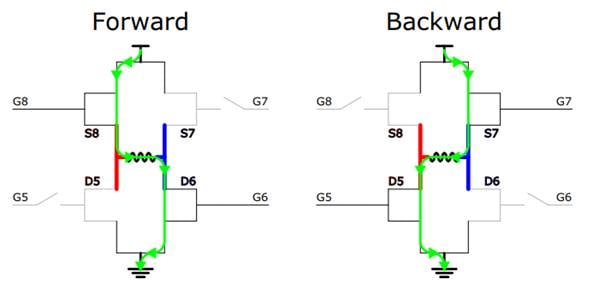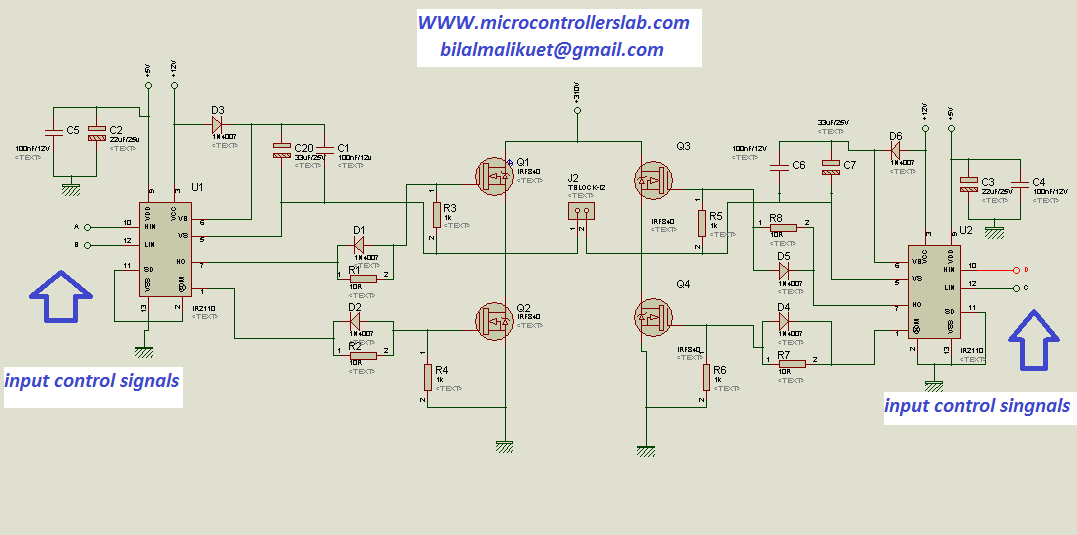

- Half bridge mosfet driver circuit how to#
- Half bridge mosfet driver circuit drivers#
- Half bridge mosfet driver circuit Pc#
- Half bridge mosfet driver circuit series#
I was able to capture something like -7 V across the body diode for several microseconds, without ANY SIGN of the body diode starting to turn on. Now, you say, "what about the body diode?" Well, I did measurements, and the FET body diodes are glacially slow to turn on.

This current is way too large, and destroys the driver chip, in the process, turning both transistors on at the same time and blowing everything out.

Current is flowing out through the inductance, and without the low-side transistor on, the current ends up flowing out through pin VS of the driver.

Then, the high-side transistor is shut off, but the low-side has not turned on, yet. So, here's the scenario : The high-side transistor is on, sending current out from the midpoint of the two transistors to the inductive load. One of the things I found out was that the inductance of the load causes currents to flow that the driver cannot handle.
Half bridge mosfet driver circuit drivers#
I make some PWM servo amps that have similar half-bridge stages, and use IR gate drivers in them. With just one cap, the design is cheaper (in case you need to buy those large caps) and the loop inductance and ESR is lower. Use only one rated at 400V and tie the other end of the transformer to a capacitive divider. EDIT: Also, if you do not need dual input voltage range, there is no point in using two of those electrolytic caps in series. There is no way around it with this simple IC. (something in the ballpark of 1uF 630V here) Not sure why wraper is hating your bias resistor - some is needed for sure, to start operation of the converter. And if they can't, separate decoupling foil type capacitor has to be used directly across the mosfet pair. The decoupling capacitors must be in close proximity of the mosfets.
Half bridge mosfet driver circuit Pc#
I see you copied probably from PC ATX supplies, nothing wrong with that, except PC supplies used NPN transistor, which are rather slow switches, unlike mosfets. Also, the whole control circuit resides directly inside the high current switching loop. Separate those two and join them exactly at the source terminal of the lower mosfet. Your GND of the control circuit is shared with a power ground. The layout does not look that bad, but it is quite bad.
Half bridge mosfet driver circuit how to#
What's wrong with my circuit? How to save those FETs? Please help. I've also tried with the gate-source pull-down resistor and gate to chip reverse diode.
Half bridge mosfet driver circuit series#
Here you can see, there is only the gate series resistor. Last two days I've damaged total 9 FETs and 5 chips. Sometimes both mosfets burns, sometimes only the high side one. There is no special situations when FETs are burning, sometimes with heavy load, sometimes with light load, and sometimes without any load. But within a few moment, MOSFETs are burning randomly, and sometimes the chip also. I've then connected it to 220V and checked the pulses again, still OK. Before connecting to 220VAC, I've powered it with 24VDC bench power supply and measured the gate pulses. It is designed in a way to reduce the noise and transient to help the stability of the device.Hello, I'm trying to make a half bridge converter based on the self oscillated chip IR2153 with an input of 220VAC and output of 12VDC. The PCB layout of the schematic demonstrated in figure-2. You must inject your PWM pulse to the IN pin as well. Then you must apply a steady state logic level voltage to this pin to activate the chip. The SD pin has pulled down with a 4.7K resistor. If you are sure that your load voltage does not pass a threshold (for example a 12V DC motor), then you can decrease the voltages of the capacitors to 25V for instance and increase their capacitance values instead (for example 1000uF-25V). So I used 100V rated capacitors at least. The maximum tolerable MOSFETs voltage is 100V. The capacitors C1 and C2 are used to reduce the motor’s noise and EMI. That’s the reason why MOSFET drivers like IR2104 are useful. There is no problem with the high input capacitance of the IRFP150 MOSFETs. The floating channel can be used to drive an N-channel power MOSFET or IGBT in the high side configuration which operates from 10 to 600 volts.” The IR2104 drives the MOSFETs in a half-bridge configuration. The output drivers feature a high pulse current buffer stage designed for minimum driver cross-conduction. The logic input is compatible with standard CMOS or LSTTL output, down to 3.3V logic. Proprietary HVIC and latch immune CMOS technologies enable ruggedized monolithic construction. According to the IR2104 datasheet : ”The IR2104(S) are high voltage, high-speed power MOSFET and IGBT drivers with dependent high and low side referenced output channels.


 0 kommentar(er)
0 kommentar(er)
